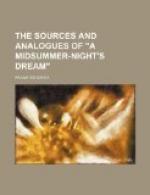King Oberon forgotten had
That he for jealousy ran mad,
But of his Queen was wondrous glad,
And asked how
they came thither:
Pigwiggen likewise doth forget
That he Queen Mab had ever met,
Or that they were so hard beset,
When they were
found together.
Nor neither of them both had thought
That e’er they had each other sought,
Much less that they a combat fought,
But such a dream
were loathing:
Tom Thumb had got a little sup,
And Tomalin scarce kissed the cup,
Yet had their brains so sure locked up,
That they remembered
nothing.
Queen Mab and her light maids, the while,
Amongst themselves do closely smile,
To see the King caught with this wile,
With one another
jesting:
And to the Fairy Court they went
With mickle joy and merriment,
Which thing was done with good intent:
And thus I left
them feasting.
* * * * *
NOTES ON TEXTS
The Legend of Pyramus and Thisbe.
See p. 31.
[1] P. 73, l. 12. let, hinder, prevent.
[2] P. 74, l. 18. vouching safe, vouchsafing.
[3] P. 75, l. 4. parget, plaster, roughcast.
[4] P. 78, l. 10. stound, position.
[5] P. 79, l. 1. meint, mixed.
[6] P. 79, l. 19. belyve, immediately.
[7] P. 80, l. 5. sicker, sure, certain.
[8] P. 80, l. 11. bespect, speckled.
* * * *
Robin Good-fellow.
See pp. 39, 63. The text here given is that of the reprint of the 1628 edition, edited for the Percy Society by J. Payne Collier in 1841. The original black-letter tract, there described as being “in the library of Lord Francis Egerton, M.P.,” is still in that collection, which is now known as the Bridgewater House Library. Collier’s introduction is characteristic; it contains a good deal of correct information, and an interesting note based on forgeries of his own in Henslowe’s Diary.
[1] P. 81, l. 20. Long-tails. Cf, Fuller’s Worthies, Kent (1811), i. 486: “It happened in an English village where Saint Austin was preaching, that the Pagans therein did beat and abuse both him and his associates, opprobriously tying fish-tails to their backsides; in revenge whereof an impudent author relateth ... how such appendants grew to the hind-parts of all that generation.”—See Murray, N.E.D. s.v. Long-tail. The earliest reference is to Moryson’s Itinerary, 1617. “Kentish-tayld” occurs in Nashe’s Strange News, 1592, sig. E 4.
[2] P. 84, l. 22. snite, snipe,
[3] P. 88, l. 23. presently, immediately.
[4] P. 90, l. 11. ho, ho, hoh! This is Robin’s traditional laugh. Cf. the refrain of the broadside, p. 144.




